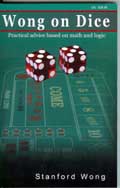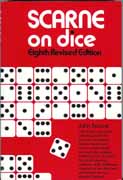
Wong on Dice

Scarne on Dice
The History of Craps
Here we are at a modern craps table. People are crowded around tossing chips right and left. The boxman, stickman and dealers are working the table and keeping track of all the action. The layout is a mass of numbers and places to bet, and there are chips on almost every conceivable spot of felt. The shooter shakes the dice in his hand, blows on them for good luck and let's them fly. All eyes are on those dice, and each gambler at the table has a chance of winning on the roll. The dice bounce off the back of the table, tumble on the felt and come up 4 – 3, seven. Winner!
There is no argument that craps is the most exciting game in a casino. Taking a chance on the roll of the dice connects you to all risk takers from the past. You are with Caesar and his army at the Rubicon, with Caesar declaring “alea iacta est” - the die has been cast. Or with Shakespeare's Richard III – “I have set my life upon the cast. And I still stand the hazard of the die.” Tossing the dice is a risk, a hazard. In fact, the modern word “hazard” has its roots in the Arabic word for die, az-zahr and was synonymous with gambling in medieval times.
Hazard was also the name of a dice game that was popular throughout much of European history. First described in print in 13th century in Alfonso X's Libro de los Juegos (Book of Games), hazard, or Azar, was also mentioned often in Chaucer's Canterbury Tales. It remained a favorite of gamblers throughout the centuries and crossed over to America with the early colonizers.
Here is a first hand account of the game from an 1833 edition of Fraser's Magazine:
“. . . the noise occasioned by proposing and accepting wagers is most uproarious and deafening. . . To prevent the noise being heard in the streets, shutters, closely fitted to the window frames are affixed, which are padded and covered with green baize; there is invariably an inner door placed in the passage, having an aperture in it, through which all who enter from the street may be viewed; this precaution answers two purposes, it deadens the sound of noisy voices at the table and prevents surprise by officers of justice.”
After Hazard migrated to the United States it began to change, gaining a new name, craps, and a new set of rules. The name change was related to one of the possible outcomes for a Hazard player. If the shooter threw a 2 or 3, he had rolled a “crabs.” When the French adopted the game, it became known as Krabs. By 1818, craps had replaced Krabs, and we were on our way to the modern game. The rules also went through a number of modifications and improvements. Hazard was a complicated game that moved slowly and was frustrating to American gamblers who wanted faster action.
John Scarne in his Scarne on Dice, credits the simplification of the rules and acceleration of the game to the African-Americans who played it first in New Orleans and then up the Mississippi. Craps didn't appear in gambling houses until the later part of the 19th century when it evolved from a private game to a banking game. In the Time-Life book The Gamblers there is a picture dating from between 1880 and 1900 that clearly shows an early version of a house craps table complete with 6 and 8, field and come bets.
In 1907, John H. Winn, “the father of modern craps” according to Scarne, introduced a series of innovations that would make craps the most popular casino game in America and around the world for the next seventy-five years. His most lasting contribution was to change the layout of the banking game to include the “don't pass” line. This element provided twice the action for bettors and also hedged against crooked dice. If you could bet either win or lose on a roll, the chances of being cheated by loaded dice were cut down greatly.
By 1914, most of the elements of modern craps were in place including Big 6 and Big 8, hard ways, and action on points. The legalization of gambling in Nevada in 1931 brought craps to the attention of countless gamblers. Craps became even more popular during World War II when servicemen took dice with them to while away their leisure hours. Nearly a hundred years after Winn's innovations, craps is making a comeback as a cool game to play. As you stand there soaking up the excitement, it's easy to see why. The history of craps isn't as dull as you may have thought!
References:
John Scarne, Scarne on Dice, (Harrisburg: Stackpole Books, 1975), pp. 32-42
The Gamblers, (Alexandria: Time-Life Books, 1978), pp. 14-15

